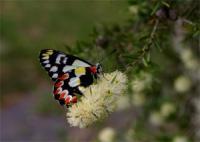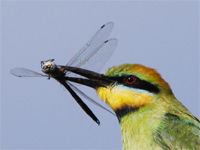I caught this Black Honeyeater, an adult male with some pale moult feathers about the head, wending its way down to the water for a drink last evening. It flitted in during a break between bursts of larger honeyeater activity. A most striking bird.
The Black Honeyeater, known until recently as Certhionyx niger is now Sugomel nigrum. As the extract from Wikipedia below shows, it has provided a field day for taxonomists!
The Black Honeyeater was first described by English naturalist John Gould in 1838 as Myzomela nigra, using as the species name the Latin adjective niger “black”. The genus name was derived from the Ancient Greek words myzo “to suckle” and meli “honey”, and referred to the bird’s nectivorous habits. Italian ornithologist Tommaso Salvadori described it as Glyciphila nisoria in 1878, though he incorrectly wrote that it originated in New Guinea. In the 1913 Official Checklist of the Birds of Australia, Australian amateur ornithologist Gregory Mathews placed the Black Honeyeater in the genus Cissomela with the Banded Honeyeater. He then placed it in its own genus Sugomel in 1922, the name being derived from the Latin sugo “I suck”, and mel “honey”. In 1967 ornithologist Finn Salomonsen transferred the species from Myzomela to the genus Certhionyx, which also contained the Banded Honeyeater (Certhionyx pectoralis) and Pied Honeyeater (Certhionyx variegatus), and later authorities accepted this classification. Australian ornithologists Richard Schodde and Ian J. Mason kept the three in the same genus, but conceded the basis for this was weak and classified each species in its own subgenus—Sugomel for the Black Honeyeater.
In a 2004 genetic study of nuclear and mitochondrial DNA of honeyeaters, the three species classified in the genus Certhionyx were found not to be closely related to one another. Instead, the Black Honeyeater was closely related to species within Myzomela after all. However, it was an early offshoot and quite divergent genetically, leading study authors Amy Driskell and Les Christidis to recommend it be placed in its own genus rather than returned to Myzomela. It was subsequently moved to the resurrected genus Sugomel. A 2017 genetic study using both mitochondrial and nuclear DNA indicates that the ancestor of the Black Honeyeater diverged from that of the Scaly-crowned Honeyeater (Lichmera lombokia) just under a million years ago, and the two have some affinities with the genus Myzomela. It is identified as Sugomel nigrum by the International Ornithological Committee’s (IOC) Birdlist. Mathews described two subspecies—Myzomela nigra westralensis from Western Australia on the basis of smaller size and darker plumage, and Myzomela nigra ashbyi from Mount Barker, South Australia, on the basis of larger size and paler plumage —neither of which is regarded as distinct today.
DNA analysis has shown the honeyeater family Meliphagidae to be related to the Pardalotidae (pardalotes), Acanthizidae (Australian warblers, scrubwrens, thornbills, etc.), and the Maluridae (Australian fairy-wrens) in a large Meliphagoidea superfamily. The Papuan Black Myzomela, (Myzomela nigrita), found in Indonesia and Papua New Guinea is also known as the Black Honeyeater. It is a different but related species.
















Lovely bird. Great photos, Geoff. Lucky you, well done, Celia
The taxonomy wars are always fun. A couple weeks ago I came across an article mentioning the Tagula Butcherbird (Cracticus louisiadensis) which lives on the island of Tagula off the southeastern tip of PNG. It looks just like a black butcherbird (Cracticus quoyi) – and not too different from the common pied butcherbirds who come to my yard.
I had a fine time reading up about the island of Tagula and looking at it on Google Earth. But is the red-list endangered Tagula Butcherbird any different from the least-concern Black Butcherbird? Who knows? But I’m sure many academic ornithologists will have immense fun arguing about it. 😀
Great photos Geoff, and thank you for the well documented information.
Hi Geoff,
Great article mate and well researched. I’m left wondering as to how much, if any, political correctness has found its way into the ranks of the IOC?
It seems that words like nigrita, nigra, niger, and nigrum are finding their way ;out the door’ when it comes to the words used for describing species. Indeed, niger is the Latin word for Black, but one can hardly see the Latin people worrying too much about future political nonsense.
As for ‘our’ Black Honeyeater, I think the name Sugomel sums him up perfectly, I suck honey.
Bruce.
Hi Geoff. Loved the article above. I’d never heard of the Scaly-crowned Honeyeater before. Turns out that it lives in tropical and subtropical forests in Indonesia. Lisa and I popped down to the dam and surrounding forests at South German Track this morning. We saw at least 3 Black Honeyeaters (1 male, 2 female), a couple of Yellow-plumed Honeyeaters, a flock of Little Lorikeets, a couple of needletails, and about 25 other species. What a spot!
In some ways, it’s nice to add the Black Honeyeater and Yellow-plumed Honeyeater to my local area bird list. However, on reflection, it’s not a great sign when mallee and arid zone birds become semi-regular visitors or residents in the temperate woodlands of central Victoria.